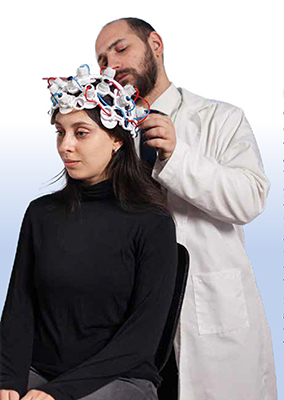
Treating disorders of the central nervous system (CNS) is notoriously challenging, particularly in the fields of psychiatry and neurology. Despite substantial investment, many drugs have failed to demonstrate efficacy in late phase clinical trials, leaving sponsors with few viable options for advancing their compounds, physicians struggling to decide which treatments to give to their patients, and patients in need of effective therapies. Digital biomarkers, which capture physiological and behavioural data have the potential to revolutionize CNS drug development and clinical practice. In this article, we explore the benefits of digital biomarkers for clinical development, physicians, and patients, as well as the challenges presented by their use.

Disorders of the CNS, which include a wide range of psychiatric and neurological conditions such as Alzheimer’s disease, schizophrenia and depression, have a profound impact on individuals and their families. Despite significant investment in research and development, the provision of new effective treatments for these clinical indications remains a significant challenge. One major issue is the difficulty in objectively measuring treatment response and disease progression. Another, and less frequently discussed issue, is how to identify the specific underlying biology in a heterogenous pool of patients presenting with similar symptoms. Traditional clinical diagnostic tools and endpoints, such as clinician ratings or patient-reported questionnaires, are subjective, time-consuming and cannot fully capture the complex and heterogeneous nature of these disorders. In recent years, the use of digital biomarkers has emerged as a promising approach to address these challenges. In addition to the well-known electronic methods of data capture, such as brain imaging and EEGs, digital tools such as wearables and smartphones capture physiological, behavioural, and environmental data that can provide objective and continuous measures of disease activity and treatment response. This article provides a short summary of the many benefits that digital biomarkers can bring to CNS drug development, clinical practice and to the patients themselves, while acknowledging the challenges to be overcome to enable their universal acceptance and use.

One definition of a biological marker (biomarker) is that it is a “characteristic that is objectively measured and evaluated as an indicator of normal biological processes, pathogenic processes, or pharmacologic responses to a therapeutic intervention” [National Institutes of Health]. Even more simply, a biomarker can be described as a medical sign (rather than symptom, which can be subjective). A useful biomarker needs to be objectively measurable, have good sensitivity and specificity for the process or response that it is predicting or measuring and be shown to be reliable.
We have become familiar with the concept of analysing biological samples to identify biomarkers which can be used for a variety of purposes. In cancer for example, biomarkers can be used for screening to check cancer status (e.g. prostate surface antigen from blood), to confirm a specific diagnosis (immunohistochemistry of tissue), predict a response to treatment so the appropriate chemotherapy can be used (eg HER2 expression in breast cancer), monitor response or progression (eg CEA in breast cancer). A digital biomarker is a measurable indicator of a biological, physiological, or behavioural process that is captured using digital technologies, such as computers, imaging devices, smartphones, wearable devices, or sensors. Like biomarkers from biological samples, digital biomarkers can be used to monitor health and disease, evaluate treatment response, and predict clinical outcomes. Examples of digital biomarkers include tools to measure heart rate variability, activity levels, sleep quality, speech patterns, and cognitive function. These biomarkers can be used to monitor a wide range of health conditions, including cardiovascular disease, diabetes, neurodegenerative diseases, and mental health disorders.

Unlike oncology there are few psychiatric and neurological conditions with accepted biomarkers, either from biological samples or digital data collection. Diagnosis and monitoring of patients is largely based on clinical assessments such as the WHO’s International Classification of Disease or the American Psychiatric Association’s Diagnostic and Statistical Manual for psychiatric illnesses, the Mini-Mental State Examination or Montreal Cognitive Assessment for dementia screening, and a wide range of self-report questionnaires and pencil & paper-based tests to measure psychiatric symptoms and provide cognitive evaluation. Even with the availability of neuroimaging for some indications, diagnostic decisions are still mainly based on patient self-report and subjective clinical assessments.
There are several challenges associated with these current methods. Importantly, diagnosis and monitoring based on patient symptoms does not account for the specific biological processes that underpin the patient’s disease. This becomes even more complex when patients have co-morbidities, such as depression and anxiety. In oncology for example treatment is no longer based on the location of the tumour but on disease-specific markers and patients are stratified based on the specific biological processes causing the symptoms. This approach is beginning to be applied to CNS disorders and represents an opportunity for more successful psychiatric and neurological drug development and subsequent patient care. A second challenge is that as some of the traditional tests in psychiatry and neurology are based on patient reports of symptoms, the patients are required to remember and describe how they have been feeling or what they have experienced since the last visit to the clinic. This method, particularly considering the cognitive symptoms experienced by many patients with psychiatric conditions, provides subjective and unreliable data which in any case cannot be verified. Also, the variability of some neuropsychiatric symptoms means that testing over multiple days can be beneficial to correctly evaluate the true health status of the patient, by testing on both “good days” and “bad days”. Finally, the traditional tests, including EEGs and brain scans, in addition to being limited to being conducted at the clinical site, can be time-consuming both to conduct and to analyse requiring significant healthcare resources. The traditional methods therefore place a heavy burden both on the clinical site and the patient.
Digital cognitive biomarkers have been used for some years within drug development to monitor drug activity within the central nervous system. These biomarkers, which provide objective, repeatable and reliable indicators of cognitive performance, can include measures such as attention, memory, processing speed, and executive function, and are obtained through various digital-based tasks such as reaction time tests, working memory, and visual searches. Performance on these tests has been shown to correlate with activity in specific processes and pathways in the brain and so provide an opportunity for identifying patients with specific disease sub-types and evaluation of treatment response in areas of psychiatry and neurology. Patients could then be prescribed the correct treatment for their condition based on its underlying biology.
With regards to unreliable reporting by patients and opportunity for testing being limited to clinic visits, digital biomarkers allow automatic or scheduled daily data collection over multiple days and more easily and reliably demonstrate the true health status of the patient. Wearables and at-home devices that can monitor, for example, patient activity or sleep biomarkers and that can be correlated with patient symptoms are showing promise in clinical studies. Reduced activity in a patient may, for example, be a marker of low mood. Such software is easily delivered through commonly used devices such as smartphones, smart watches or other smart activity monitors. Digital cognitive testing can similarly be delivered either in a clinic setting or while the patient is at home using smartphones, tablets and wearable devices. The continuous or repeated nature of the data collection captures the day-to-day variation in patient symptoms more accurately, including the more subjective responses by patients about their symptom states, allowing trends across weeks or months of treatment to be better identified. This automatic data collection provided by digital biomarkers both allows the clinical sites to see more information without needing significantly extra resource and also minimises patient burden.
Conducting late-phase clinical trials is time-consuming, costly and complex; and the risk of failure when developing treatments for psychiatric and neurological conditions is high, as shown by a number of recent clinical trial failures. Assigning the correct differential diagnosis is particularly challenging in psychiatric conditions where co-morbidities are often present, such as both depression and anxiety. Utilising digital cognitive biomarkers to group patients with similar behavioural profiles and underlying pathology may reduce the inherent heterogeneity of clinical trial populations and so increase the likelihood of the success of the clinical trial. Stratification and objective measures of treatment response also provide opportunity for reduced sample sizes.
The collection of data between clinic visits can enable more efficient clinical trials by reducing the need for frequent site visits by the patient and facilitates the implementation of decentralised clinical trials by allowing for remote monitoring of patients by both the site monitor and the physician. This can reduce patient burden, reduce costs, and increase the speed of data collection. Reduced patient burden can, further, improve the rate of enrolment to a trial.
Digital biomarkers can also provide several benefits for physicians in clinical practice. First, they can help to personalize treatment decisions by providing objective measures of disease activity and predicted and actual treatment response for individual patients. Where this is e.g., a cognitive biomarker that is predictive of treatment response or side effects it can inform the physician’s decision on choice of treatment while that patient is at their appointment, as they can be completed within just a few minutes
Second, digital biomarkers can facilitate remote monitoring of patients, allowing for more frequent and accurate assessment of disease activity and treatment response. This can enable more accurate and timely adjustments to treatment regimens, leading to improved outcomes and reduced side effects. It may also enable the earlier detection of disease relapse or progression, allowing for timely intervention and potentially improving long-term outcomes.

Digital biomarkers can provide several benefits for patients. The ability to predict likely response to a drug can enable more personalized treatment decisions, ensuring the patient is on the right drug and leading to improved outcomes and reduced side effects. Remote monitoring of patients may improve patient engagement and satisfaction by providing more continuous and objective measures of disease activity and treatment response as well as reducing the need for frequent site visits.
Within the context of clinical trials reducing the burden of frequent and long site visits may enable patients to participate in clinical trials more easily, particularly where the assistance of a carer is needed when travelling.
Despite the potential benefits of digital biomarkers, their use in clinical development and practice also presents challenges. One of the main challenges is ensuring the validity and reliability of digital biomarkers, which requires rigorous validation studies and standardization of measurement protocols. This is particularly important given the wide range of digital biomarkers under development and the potential for variability in data collection across different devices and platforms. The advantage of digital cognitive biomarkers is that much validation work is already complete and they have been shown to be reliable, robust, and consistent across different devices.
The FDA and EMA have already provided guidance and commentary on the use of digital biomarkers within drug development although definitive guidelines on acceptability and standardised definitions are still required. The first regulatory qualification of a digital endpoint from wearable devices; a measure of stride velocity to quantify ambulation ability of patients with Duchenne muscular dystrophy; was announced in August 2021. Collaborative groups such as Critical Path Institute’s eCOA Consortium and Patient-Reported Outcome Consortium as well as the European Federation of Pharmaceutical Industries and Associations are attempting to engage regulatory agencies and other stakeholders for the purpose of standardising terminology and understanding the regulatory environment for digital biomarkers.
In conclusion, the use of digital biomarkers in neuroscience presents significant opportunities for advancing drug development and improving clinical practice. Digital biomarkers have the potential to personalize treatment decisions, provide more precise and objective measures of disease activity and treatment response, enable more efficient clinical trials, and improve patient outcomes. Addressing the challenges of digital biomarkers will require collaboration across stakeholders, including regulators, industry, clinicians, and patients. With continued innovation and investment, and considering the high interest and activity by academics, commercial R&D and regulators digital biomarkers have the potential to revolutionize the field of neuroscience and improve the lives of millions of patients.
Treating disorders of the CNS is challenging, particularly in psychiatry and neurology. For sponsors when promising drugs fail in late phase clinical research, physicians deciding which treatments to give to their patients and ultimately for the patients who need effective treatments. This article suggests that digital biomarkers could be an important part of the solution.